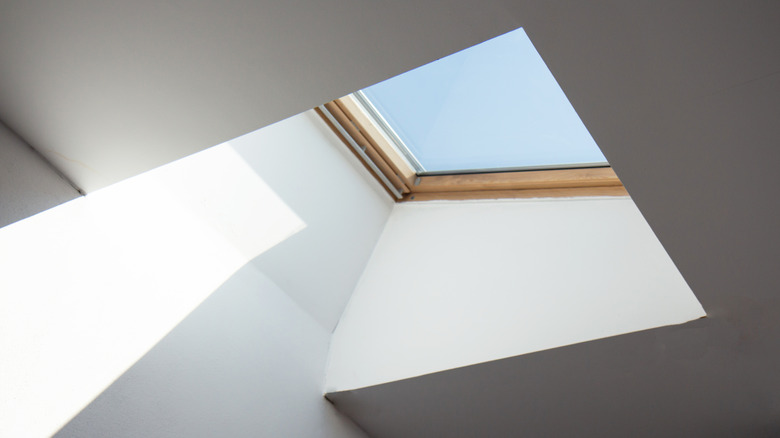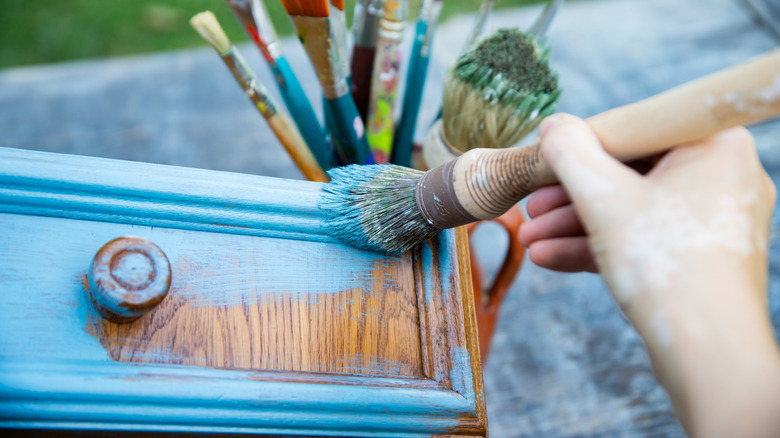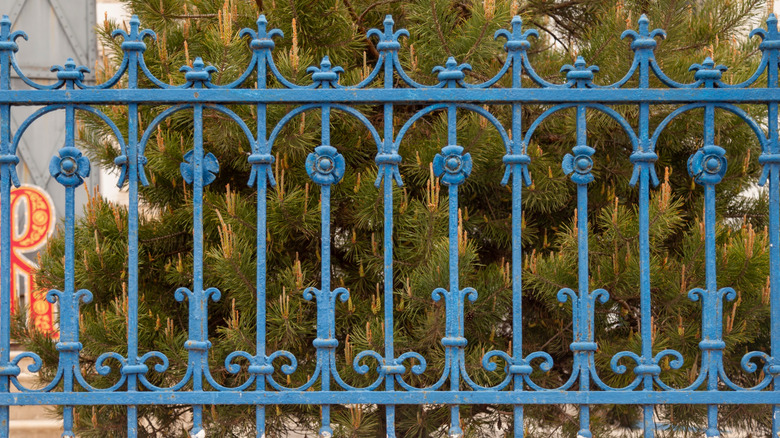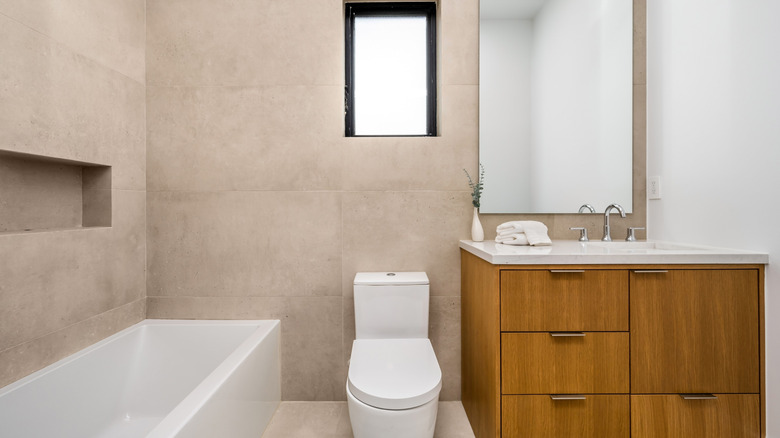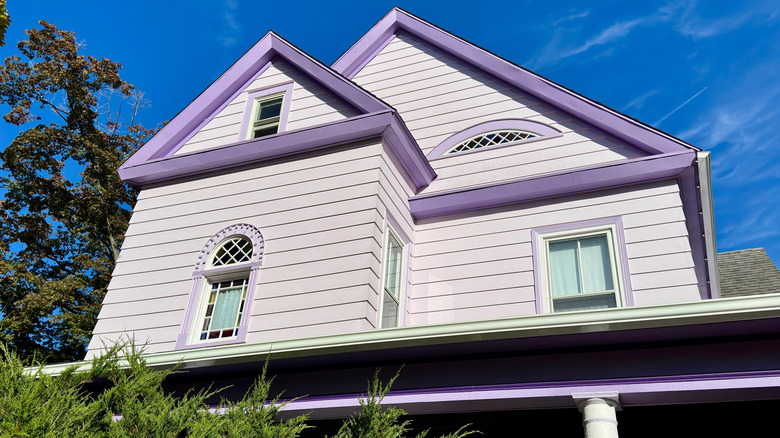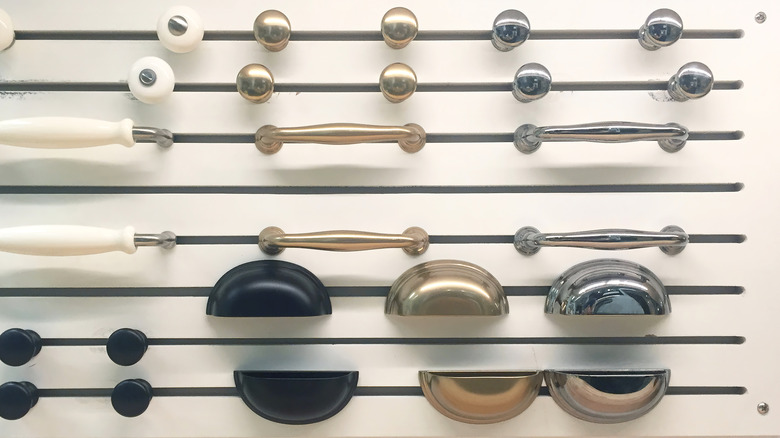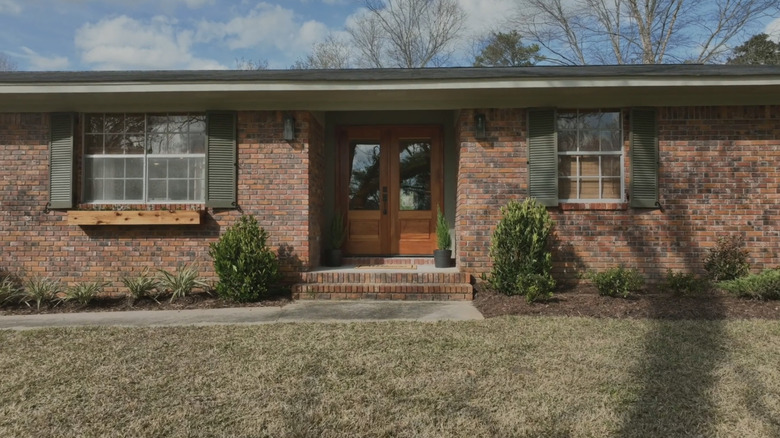Design Advice To Ditch, According To HGTV's Erin Napier
We may receive a commission on purchases made from links.
Erin Napier knows a thing or two about designs to ditch. The "Home Town" star and longtime HGTV darling is known for her very sweet, very southern, and very practical takes on home decor and construction. Alongside her husband Ben, Napier's show focuses on transforming the heart of worn out properties and reviving their soul, making them more livable in more ways than one. Over her many years in the biz, she's come across more than one thing that just doesn't work — and she's here to warn you about it so you don't make the same mistakes.
Some of her advice is easily actionable. As in, you can pivot your plans right after reading to avoid a major design disaster. Other tips you might have to hold onto for a while. They'll only become relevant if you are house hunting or about to pony up for a major renovation and want to make sure you're getting the most value for your money. Yet either way, Napier's advice will hold true. She doesn't think you should ditch this advice because it's just out of style this year, or has only recently been overdone. Instead, it'll be a "don't" forever because of how it reduces the function and form of your space. So whether you need it now, or 10 years from now, you can count on her recommendations.
Skylights always add light and functionality
Seeking ways to improve natural light in your home is typically great design advice, as its presence can make the tightest of spaces seem brighter and airier. However, Napier is quick to suggest avoiding skylights. They might have been common in the past, but they are more of a hassle than they are worth to maintain. Because of this, she insists they shouldn't be included in newer homes. "We never see a skylight on a house anymore. People stopped doing it because they get very leaky," Napier said on Season 8, Episode 1 of "Home Town." In addition, skylights can be hard to keep clean. You need a ladder to clean the inside of the glass, and you need to take a trip up to the roof to wipe dirt and pollen off the exterior.
If you already have skylights, Napier's best advice is to consider removing them next time you update your roof. "A new roof really makes a house feel completely new," she said of her choice to re-roof her client's home in the episode. Roofs last an average of 15 to 50 years, depending on the type of material, shorter if there is a major event like a storm that causes damage. So, the best path forward to avoid this outdated ceiling feature is simply to avoid including them in any renovation plans, and being a little more wary of buying older houses that have them already.
Perfectly styled rooms should always be the goal
As a big fan of HGTV, you might feel like you want to mimic the perfectly styled rooms you see during the big reveals. If your home looks like a "before," you might spend plenty of time and money trying to get it to look more like an "after." Yet Napier wants you to ditch this design advice and start embracing the chaos. "I've become bored of the photos of perfectly styled and staged interiors you see so much of in the online world and wanted to write a book celebrating the imperfection of our houses," she shared on Instagram. "The styling can be an outward reflection of who we are and what we love — but really, our houses are the backdrops of our lives and celebrations and failures, of growing families," she wrote.
To bring this mindset into your own home, start by incorporating items that tell your personal story rather than just blindly following trends. Display family heirlooms, your kids' artwork, or even mementos from your favorite vacation spot. Let books stack naturally (don't worry about color-coordinating them!) and don't stress over perfectly matching furniture. Focus on comfort and memories over symmetry and polish. Napier thinks that you should ask yourself not just how a space looks, but how it feels to live in. Embracing imperfection doesn't mean neglecting design. It just means creating a space that evolves with you, rather than one that looks staged for someone else.
Painted furniture enhances the overall look
Flipping furniture is quite popular these days, but it's not something that Erin Napier can get behind, at least in most cases. "I hope we'll finally see people stepping away more from painted furniture and toward the warmth of natural and stained wood," she told PopSugar when describing design trends in 2018. "The organic movement in wood grain is art!" She's tired of seeing painted furniture in homes because it ruins the magic of the original bare finishes.
While painting furniture can be a quick way to brighten up a room or add some color, Napier encourages using natural, classic materials. Wood, whether left as is or lightly stained, brings a cozy feel and interesting texture that painted surfaces often don't have. The key is in proper care and thoughtful styling.
You can enhance interesting grain patterns or unique tones with the right wood finish, like oil, wax, or a clear matte polyurethane. These bring out the wood's depth and character. In addition, regular dusting and occasional conditioning will keep the wood from drying out and maintain its luster over time. If it's already been painted, a stripper like Smart 'n Easy Paint & Varnish Remover Gel can easily peel back years of painting to reveal the treasure underneath.
Overly ornate wrought iron suits all houses
Wrought iron gates, fences, and detailing can add a much-needed dramatic flair to the overall curb appeal of your house. However, the tight, visually intense design doesn't suit all types of home styles, so it shouldn't always be present. In the Season 5 episode "Closer to Mom," Napier expressed frustration with how often people choose to include these gates in places they don't belong. "I just hate the overly ornate wrought iron, on a house that is specifically all about straight lines," she said. The clash of swirls and angles doesn't mesh visually and can easily create chaos instead of the order you might prefer for the exterior of your home.
To fix this on the show, Napier's crew removes the iron. Although there is nothing wrong with wrought iron on its own, in this instance, it's out of place. Instead, they replaced it with a slatted wood wall, which better fit the overall mid-century vibe of the property. If you're not sure whether wrought iron works well for your home's exterior, start by checking the style and lines of your house. Homes with simple and minimalist designs usually don't go well with fancy metal decorations, while Victorian or Mediterranean-style houses often match better. If you're unsure, choose simpler designs like straight bars or geometric patterns in black or matte bronze, which give shape without looking too busy.
Small spaces should always be decorated in neutrals
You might have heard that the smaller the space, the more neutral the decor needs to be. This is so it doesn't become too visually overwhelming or boxed in with the limited square footage available. Yet both Erin and Ben think this isn't always the best way forward. "If you're revamping a tight space like a bathroom or entryway, it's easy (and safe) to stick to one color palette and keep the design simple," they told Reader's Digest. This can easily become boring, though — so you shouldn't be afraid to really infuse these smaller spaces with a big amount of personality.
Color and texture can enhance small spaces, making them memorable instead of a write-off. "When looking for subtle ways to add color in bathrooms, installing a patterned tile backsplash or even unique and unexpected fixtures can bring life to a bland space," they continued. A great way to start is with wallpaper. Even if you are a renter, adding fun, punchy wallpaper can infuse plenty of color and personality without breaking the bank. The Napiers even have their own line of easy-install peel-and-stick options. Taupe & Multi Heirloom Floral is for the flower lovers, while Navy and Metallic Gold Star Splendor is for those who prefer color to do the visual heavy lifting.
Painted historic trim enhances the vibe
When trying to modernize your historic home, you might think that a fresh coat of paint is the only facelift it needs. However, on Season 7, Episode 3 of "Home Town," Napier actually warned against painting certain parts of your property's exterior. "Most people want to paint their historic trim," she said about the client's Victorian house. "I think it's a huge mistake 90% of the time." The reason is that it's not easily reversible, at least not without a lot of effort to strip the paint off again. "Once you paint it, you can't go back," Ben added.
While some might love painting to give personality, Napier is a fan of enhancing the natural wood. Instead of paint, try using a sealant or finish to enhance the natural beauty of the wood. Much like Napier's take on furniture, trim should be left on its own to shine instead of being covered up. Start by assessing the overall condition of your historic trim. If the wood is in good shape (with crisp details and minimal rot, for example), it's worth preserving. Whether you choose a gloss or matte finish, neither will cover up the beauty of the pattern. Because trim is exterior, no matter what option you choose, it should be waterproof to protect against the elements, like the Seal-Once Marine Premium Wood Sealer.
All of your metals have to match
When selecting finishes for your home, especially the kitchen and the bathroom, you might be concerned about ensuring things like faucets, drawer pulls, or even lightswitch covers all coordinate — yet Napier thinks there can be beauty in a little mismatch. "Don't be worried about matching all your metals," she wrote on her blog, Laurel Mercantile. "In our kitchen, I've got brushed brass, unlacquered brass, stainless steel, copper, and oil-rubbed bronze. All the metals work together to keep it feeling warm and not so boring and matched."
The key to success here is to make sure items that come in pairs or groups are still coordinated. Unless you want to go for a chaotic maximalist decor, then your drawer pulls should match each other, even if they don't go with your door handles. The same with cabinet pulls, and power points, too. Don't be afraid to mix matte and shiny, either, as Napier does both in her own home, too. Having this high level of visual contrast creates personality, which is great for people who don't want their spaces to feel flat and plain.
When in doubt, paint a brick exterior
Whitewashed houses are all the rage, while simple red bricks might be falling out of favor. Even more so, are the darker bricks on the house in the Season 7 episode "Wood, Brick and Clay." Many people might try to get rid of darker bricks, but Napier actually loves them. "People are always painting this kind of brick, and I think that's a mistake," she said. "You can work with this brick if you find a way to take the darkest color in it and use it as an accent somewhere in the house."
In this case, she painted the shutters a hunter green, similar to the Matte Heirloom Traditions Paint, to enhance the earthiness of the existing brick's tone. She also incorporated window boxes and better landscaping to add more green. In your own home, don't rush to paint dark or red brick. This can be irreversible and might strip the home of its character. Instead, identify the undertones (e.g., browns, grays, deep reds) and use them to your advantage, just like Napier did. Use wood or metal accents (like porch beams, planter boxes, and even front doors) that match the home's natural palette. These are easier to swap out than painting and repainting brick.

